



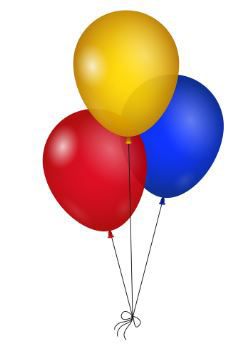 2025 Annual Weekend and AGM
2025 Annual Weekend and AGM 
(Uploaded 06/07/25)
All That Jazz....
The schedule for the weekend had been changed to accommodate a Saturday visit to the pattern books at Stoke but unexpected events also caused some further alteration to the plans. Sadly, the first was the death of Terry Lockyer, the husband of Committee member Carole the weekend before the Telford gathering. The second was our magazine editor Chris Davenport suffering a heart attack only a day or two later. Some shuffling of who was doing what in the timetable and variations on who was bringing what for display were quickly organised and in the best tradition the show went on although with some much-missed faces.

Because of the changed format instead of the usual Saturday welcome address Chairman Gerry Pearce greeted members and overseas visitors prior to the Friday social evening quiz, once again arranged by Olwen Dudgeon. The usual groans accompanied each round with questions on cat characters, pictures of celebrities, the colour black, and a Wileman/Shelley cup code. When points were added up the winners of the traditional tub of chocolates were the Richmond team.
The next morning coach trip to Stoke went as scheduled and on arrival the group was split into two, while the first went to look at the pattern books the second had time to look round the Museum while spotting the odd piece of Shelley or Wileman on display.

The two groups then swapped places after a cup of tea or coffee. Some spent their time looking for a specific pattern or crest, others just enjoyed looking at the wonderful illustrations. Afterwards there was a short walk to the Victoria Lounge for a buffet lunch where the group was unexpectedly and pleasantly serenaded by members of the Biddulph Male Voice Choir who were also visiting.
On return to Telford there was a chance to vote on the pot show entries and view the displays including the In Situ “Cocktails with the smart set” before the talks began.

First was John Barter on Art Deco and the Paris Exhibition of 1925.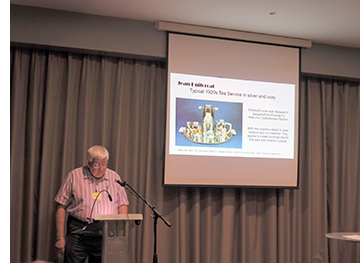
At the beginning of the twentieth century Paris was the epicentre of design and an exhibition was planned but the First World War and then the reconstruction that followed necessitated delay.
However, by 1925 they were ready and the exhibition, staged in the centre of Paris, helped stimulate the international cross-fertilisation in many artistic and practical forms including architecture, interior design, textiles, metalwork, glass and ceramics.
Influences included tribal art from the colonies, the discovery of Tutankhamen, Frank Lloyd Wright’s use of concrete, steel and glass in the USA and the BauHaus in Germany. An illuminated glass fountain by Rene Lalique featured in postcards and illustrations. The poster and cover of the Official catalogue, designed by Robert Bonfils, shows a leaping deer, a running lightly clad female figure and a basket of flowers which are considered today quintessential Deco symbols. John showed a range of images of the various Pavilions and contents principally by French designers and companies, but other countries had their own Pavilions including Great Britain, Czechoslovakia and Japan.
A Gordon Russell cabinet of English walnut inlaid with ebony was among the gold award winners. A.J. Gray also exhibited in the British pavilion, and it is known Clarice Cliff visited and was presumably influenced by what she saw. John’s talk set the scene for the next presentation by David Cox, 'Shelley in 1925: A time for Change?'
 He tackled the question from three aspects, the key factors pre-1925, the new patterns of that year and the social context of the company.
He tackled the question from three aspects, the key factors pre-1925, the new patterns of that year and the social context of the company.
Percy Shelley had been in full charge since 1896 and was the driving force behind the company’s growth, change and prosperity which included a new trademark in 1925 that promised to be a “guarantee of the highest quality.” It was announced with the words “the worldwide reputation of Foley China has caused many cheap imitations and in future, to protect the public the real and genuine Foley China will always be indelibly marked “Shelley China.”
David suggested it was surely a great time for Shelley with the new London showroom opening in Holborn, W.H. Smedley revolutionising marketing including the Shelley Girl and Silver Book. The seeds of change were sown with the Queen Anne shape to follow in 1926 before the glories of Harmony, Mode and Vogue.
But the early 1925 entries in Pattern Book 7 gave little clues of the changes to come. Numbers 11386 – 11454 covered 11 different shapes and he says he was underwhelmed by many of the designs which appeared in the early months on the Doric shape and others. However, some later numbers did begin to show brighter patterns, and the word Jazz appears faintly with 11425 signalling change coming. From a social context in 1925 the Potteries Gazette reported 32 per cent of the labour force was on short time and by July that year 10,000 were unemployed in the potteries. David said the problem for Shelley was balancing its reputation for high quality against the need to survive in a volatile and competitive market. He finished “so was the new trademark/backstamp on 1st January 1925 the start of change for Shelley? I leave you to come to your own conclusions.”
The afternoon session concluded with an agony aunt session when question answered included how best to clean stains on Shelley and when an item is worth repairing.

The silent auction had its usual array of items for sale ranging from trios to a cucumber tray, from a lamp base to vases, helping to raise funds for the group but the event was brightened up by those who had dressed especially for the jazz themed dinner. Flapper dresses, jackets and 1920s outfits or should we say Prohibition style for the US visitors. Suitable cocktails were also on offer. Ladies looking beautiful in their jazzy dresses were presented with flowers while a group prize went to the Shelley family, Marcus, Irene and their two grandsons Thomas and Ben El Benni.
The Gala Dinner
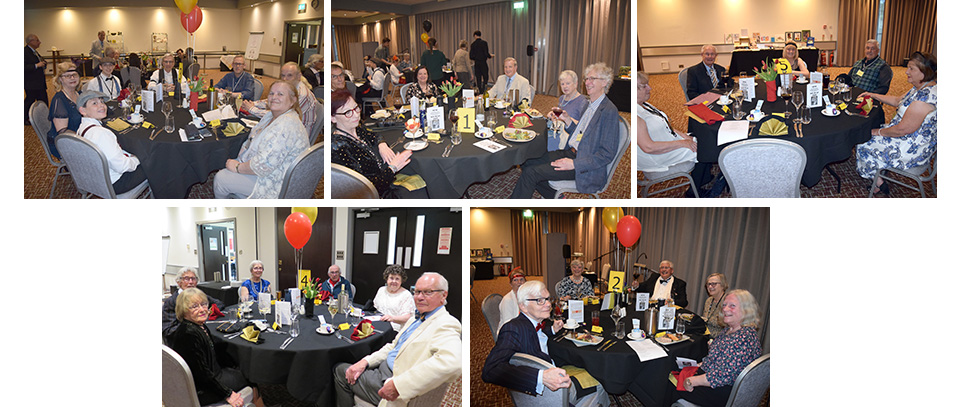
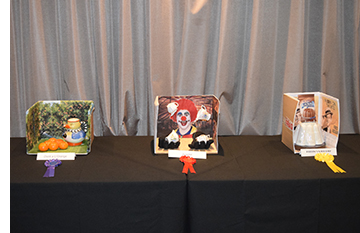
The winner of the pot show was Gerry Pearce with his entry Juggler. Since he could not present the trophy to himself it was handed over to him at the dinner by Olwen Dudgeon. Second place went to Sheila Aves with Duck a la Orange and third Sal Mansfield with Puddin on the Ritz.
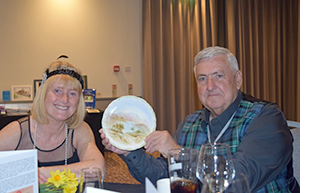
The raffle draw for a plate decorated by Ray Reynolds showing Lower Lake Killarney was won by visiting Australian Steven I’Anson, who by chance was sitting next to Ray’s daughter Sue at the dinner. After the meal a selection of poems was read from The Shelley Standard and David Whitehead.
Sunday began with the Annual General Meeting.
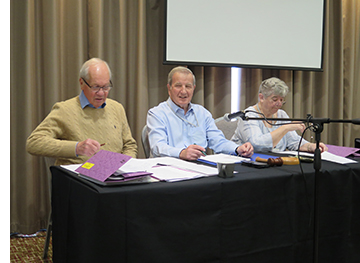 The chairman expressed thanks to the Committee for all their hard work and in particular Chris in his absence for his work on the magazines and hoped he was now recovering out of hospital and back at home. He also mentioned Brian Hill for his work on The Group’s website and Ruth Jenkins for her contribution on Facebook as well as work as events officer. Treasurer Linda Ellis said bequests had funded the trip to the pattern books and because The Group remains financially stable it was approved that the subscription rates remain the same. The Committee were re-elected.
Leigh Clark, President of the National Shelley China Club told the meeting the USA conference will be in Philadelphia between September 26-28.
The chairman expressed thanks to the Committee for all their hard work and in particular Chris in his absence for his work on the magazines and hoped he was now recovering out of hospital and back at home. He also mentioned Brian Hill for his work on The Group’s website and Ruth Jenkins for her contribution on Facebook as well as work as events officer. Treasurer Linda Ellis said bequests had funded the trip to the pattern books and because The Group remains financially stable it was approved that the subscription rates remain the same. The Committee were re-elected.
Leigh Clark, President of the National Shelley China Club told the meeting the USA conference will be in Philadelphia between September 26-28.
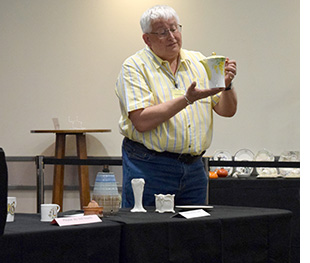
The Snake this year was with the themed letter L and John Barter described items brought by members ranging from a Laburnum coffee pot to a Lily of the Valley butter dish, and including low Lilies, a Ludlow bell, lots of lovely ladies, a lemon squeezer, a Cape Gooseberry ladle and sauceboat, crested ware for Lowestoft and a lamp base. Next year is E so get your thinking caps on.
The final talk “It’s not so Grim Up North” was by Olwen Dudgeon and friends from that area.
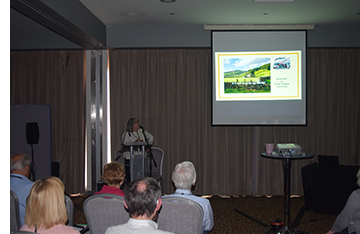
Starting in the North-East with Northumberland, using crested items, maps, commemorative wares and cup shapes she toured Newcastle, Durham, Darlington and Richmond. Chris Davenport had selected the cream of his Ripon collection for that shape which Olwen read on his behalf before moving on to the York shape. East Yorkshire highlights included Beverley Minster before stops at Gainsborough, Lincoln and Boston.
Once into Derbyshire with Ashbourne and Chatsworth patterns, Olwen handed over to Eileen Gore who described how she and Carl had investigated the tale of Dorothy Vernon featured on crested items for Haddon Hall. She lived there in the 1500s after an adventurous start to her marriage to the son of the Duke of Rutland.
Moving on to Staffordshire and then Cheshire, Paul Allen took over to describe the Chester cup shape. There don’t seem to be that many around, yet the day before he had spotted several in the pattern books.
Moving North on the West side, the Intarsio Queen of Hearts featured for author Lewis Carroll, real name Charles Dodgson born in Cheshire, a rare Beatles mug for Liverpool and items for Blackpool and Morecombe. Before going to the Lake District there was a short trip to Barrow-in-Furness where HMS Ajax, famous for her part in the Battle of the River Plate, was built. After pointing out that Lakeland is one of the few patterns where the name forms part of the decoration, the talk concluded with Carlisle shape. Some of the shapes described were on offer only minutes later at the Bring and Buy sale delighting their purchasers.
After lunch there was a general discussion and a request for suggestions for future Zoom talks and speakers before the formal events ended.
The schedule for the weekend had been changed to accommodate a Saturday visit to the pattern books at Stoke but unexpected events also caused some further alteration to the plans. Sadly, the first was the death of Terry Lockyer, the husband of Committee member Carole the weekend before the Telford gathering. The second was our magazine editor Chris Davenport suffering a heart attack only a day or two later. Some shuffling of who was doing what in the timetable and variations on who was bringing what for display were quickly organised and in the best tradition the show went on although with some much-missed faces.

Because of the changed format instead of the usual Saturday welcome address Chairman Gerry Pearce greeted members and overseas visitors prior to the Friday social evening quiz, once again arranged by Olwen Dudgeon. The usual groans accompanied each round with questions on cat characters, pictures of celebrities, the colour black, and a Wileman/Shelley cup code. When points were added up the winners of the traditional tub of chocolates were the Richmond team.
The next morning coach trip to Stoke went as scheduled and on arrival the group was split into two, while the first went to look at the pattern books the second had time to look round the Museum while spotting the odd piece of Shelley or Wileman on display.

The two groups then swapped places after a cup of tea or coffee. Some spent their time looking for a specific pattern or crest, others just enjoyed looking at the wonderful illustrations. Afterwards there was a short walk to the Victoria Lounge for a buffet lunch where the group was unexpectedly and pleasantly serenaded by members of the Biddulph Male Voice Choir who were also visiting.
On return to Telford there was a chance to vote on the pot show entries and view the displays including the In Situ “Cocktails with the smart set” before the talks began.

First was John Barter on Art Deco and the Paris Exhibition of 1925.

At the beginning of the twentieth century Paris was the epicentre of design and an exhibition was planned but the First World War and then the reconstruction that followed necessitated delay.
However, by 1925 they were ready and the exhibition, staged in the centre of Paris, helped stimulate the international cross-fertilisation in many artistic and practical forms including architecture, interior design, textiles, metalwork, glass and ceramics.
Influences included tribal art from the colonies, the discovery of Tutankhamen, Frank Lloyd Wright’s use of concrete, steel and glass in the USA and the BauHaus in Germany. An illuminated glass fountain by Rene Lalique featured in postcards and illustrations. The poster and cover of the Official catalogue, designed by Robert Bonfils, shows a leaping deer, a running lightly clad female figure and a basket of flowers which are considered today quintessential Deco symbols. John showed a range of images of the various Pavilions and contents principally by French designers and companies, but other countries had their own Pavilions including Great Britain, Czechoslovakia and Japan.
A Gordon Russell cabinet of English walnut inlaid with ebony was among the gold award winners. A.J. Gray also exhibited in the British pavilion, and it is known Clarice Cliff visited and was presumably influenced by what she saw. John’s talk set the scene for the next presentation by David Cox, 'Shelley in 1925: A time for Change?'
 He tackled the question from three aspects, the key factors pre-1925, the new patterns of that year and the social context of the company.
He tackled the question from three aspects, the key factors pre-1925, the new patterns of that year and the social context of the company.Percy Shelley had been in full charge since 1896 and was the driving force behind the company’s growth, change and prosperity which included a new trademark in 1925 that promised to be a “guarantee of the highest quality.” It was announced with the words “the worldwide reputation of Foley China has caused many cheap imitations and in future, to protect the public the real and genuine Foley China will always be indelibly marked “Shelley China.”
David suggested it was surely a great time for Shelley with the new London showroom opening in Holborn, W.H. Smedley revolutionising marketing including the Shelley Girl and Silver Book. The seeds of change were sown with the Queen Anne shape to follow in 1926 before the glories of Harmony, Mode and Vogue.
But the early 1925 entries in Pattern Book 7 gave little clues of the changes to come. Numbers 11386 – 11454 covered 11 different shapes and he says he was underwhelmed by many of the designs which appeared in the early months on the Doric shape and others. However, some later numbers did begin to show brighter patterns, and the word Jazz appears faintly with 11425 signalling change coming. From a social context in 1925 the Potteries Gazette reported 32 per cent of the labour force was on short time and by July that year 10,000 were unemployed in the potteries. David said the problem for Shelley was balancing its reputation for high quality against the need to survive in a volatile and competitive market. He finished “so was the new trademark/backstamp on 1st January 1925 the start of change for Shelley? I leave you to come to your own conclusions.”
The afternoon session concluded with an agony aunt session when question answered included how best to clean stains on Shelley and when an item is worth repairing.

The silent auction had its usual array of items for sale ranging from trios to a cucumber tray, from a lamp base to vases, helping to raise funds for the group but the event was brightened up by those who had dressed especially for the jazz themed dinner. Flapper dresses, jackets and 1920s outfits or should we say Prohibition style for the US visitors. Suitable cocktails were also on offer. Ladies looking beautiful in their jazzy dresses were presented with flowers while a group prize went to the Shelley family, Marcus, Irene and their two grandsons Thomas and Ben El Benni.
The Gala Dinner


The winner of the pot show was Gerry Pearce with his entry Juggler. Since he could not present the trophy to himself it was handed over to him at the dinner by Olwen Dudgeon. Second place went to Sheila Aves with Duck a la Orange and third Sal Mansfield with Puddin on the Ritz.

The raffle draw for a plate decorated by Ray Reynolds showing Lower Lake Killarney was won by visiting Australian Steven I’Anson, who by chance was sitting next to Ray’s daughter Sue at the dinner. After the meal a selection of poems was read from The Shelley Standard and David Whitehead.
Sunday began with the Annual General Meeting.
 The chairman expressed thanks to the Committee for all their hard work and in particular Chris in his absence for his work on the magazines and hoped he was now recovering out of hospital and back at home. He also mentioned Brian Hill for his work on The Group’s website and Ruth Jenkins for her contribution on Facebook as well as work as events officer. Treasurer Linda Ellis said bequests had funded the trip to the pattern books and because The Group remains financially stable it was approved that the subscription rates remain the same. The Committee were re-elected.
Leigh Clark, President of the National Shelley China Club told the meeting the USA conference will be in Philadelphia between September 26-28.
The chairman expressed thanks to the Committee for all their hard work and in particular Chris in his absence for his work on the magazines and hoped he was now recovering out of hospital and back at home. He also mentioned Brian Hill for his work on The Group’s website and Ruth Jenkins for her contribution on Facebook as well as work as events officer. Treasurer Linda Ellis said bequests had funded the trip to the pattern books and because The Group remains financially stable it was approved that the subscription rates remain the same. The Committee were re-elected.
Leigh Clark, President of the National Shelley China Club told the meeting the USA conference will be in Philadelphia between September 26-28.

The Snake this year was with the themed letter L and John Barter described items brought by members ranging from a Laburnum coffee pot to a Lily of the Valley butter dish, and including low Lilies, a Ludlow bell, lots of lovely ladies, a lemon squeezer, a Cape Gooseberry ladle and sauceboat, crested ware for Lowestoft and a lamp base. Next year is E so get your thinking caps on.
The final talk “It’s not so Grim Up North” was by Olwen Dudgeon and friends from that area.

Starting in the North-East with Northumberland, using crested items, maps, commemorative wares and cup shapes she toured Newcastle, Durham, Darlington and Richmond. Chris Davenport had selected the cream of his Ripon collection for that shape which Olwen read on his behalf before moving on to the York shape. East Yorkshire highlights included Beverley Minster before stops at Gainsborough, Lincoln and Boston.
Once into Derbyshire with Ashbourne and Chatsworth patterns, Olwen handed over to Eileen Gore who described how she and Carl had investigated the tale of Dorothy Vernon featured on crested items for Haddon Hall. She lived there in the 1500s after an adventurous start to her marriage to the son of the Duke of Rutland.
Moving on to Staffordshire and then Cheshire, Paul Allen took over to describe the Chester cup shape. There don’t seem to be that many around, yet the day before he had spotted several in the pattern books.
Moving North on the West side, the Intarsio Queen of Hearts featured for author Lewis Carroll, real name Charles Dodgson born in Cheshire, a rare Beatles mug for Liverpool and items for Blackpool and Morecombe. Before going to the Lake District there was a short trip to Barrow-in-Furness where HMS Ajax, famous for her part in the Battle of the River Plate, was built. After pointing out that Lakeland is one of the few patterns where the name forms part of the decoration, the talk concluded with Carlisle shape. Some of the shapes described were on offer only minutes later at the Bring and Buy sale delighting their purchasers.
After lunch there was a general discussion and a request for suggestions for future Zoom talks and speakers before the formal events ended.